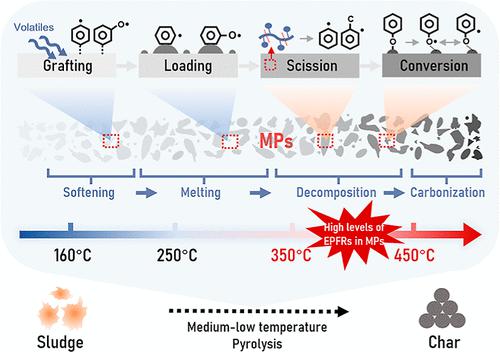当前位置:
X-MOL 学术
›
Environ. Sci. Technol.
›
论文详情
Our official English website, www.x-mol.net, welcomes your feedback! (Note: you will need to create a separate account there.)
Medium-Low Temperature Conditions Induce the Formation of Environmentally Persistent Free Radicals in Microplastics with Conjugated Aromatic-Ring Structures during Sewage Sludge Pyrolysis
Environmental Science & Technology ( IF 11.4 ) Pub Date : 2022-09-27 , DOI: 10.1021/acs.est.2c04453 Zhihang Yuan 1, 2 , Qiujie Huang 1 , Zhuoqin Wang 1 , Hui Wang 1 , Jinming Luo 1 , Nanwen Zhu 1, 2 , Xinde Cao 1 , Ziyang Lou 1, 2, 3
Environmental Science & Technology ( IF 11.4 ) Pub Date : 2022-09-27 , DOI: 10.1021/acs.est.2c04453 Zhihang Yuan 1, 2 , Qiujie Huang 1 , Zhuoqin Wang 1 , Hui Wang 1 , Jinming Luo 1 , Nanwen Zhu 1, 2 , Xinde Cao 1 , Ziyang Lou 1, 2, 3
Affiliation

|
Medium-low temperature pyrolysis is an effective method of retaining active components in sludge char. However, we found that incomplete cracking reactions resulted in residues of microplastics (MPs) remaining in the char; moreover, high levels of environmentally persistent free radicals (EPFRs) were detected in these MPs. Here, we investigated the temperature-dependent variations in the char-volatile products derived from sludge and MPs under different pyrolysis scenarios using multiple in situ probe coupling techniques and electron paramagnetic resonance spectroscopy, thereby identifying the sources of EPFRs and elucidating the corresponding formation-conversion mechanisms. The temperature was the key factor in the formation of EPFRs; in particular, in the 350–450 °C range, the abundance of EPFRs increased exponentially. Reactive EPFR readily formed in MPs with conjugated aromatic-ring structures (polyethylene terephthalate and polystyrene) at a temperature above 350 °C; EPFR concentrations were 5–17 times higher than those found in other types of polymers, and these radicals exhibited half-lives of more than 90 days. The EPFR formation mechanism could be summarized as solid–solid/solid–gas interfacial interactions between the polymers and the intermediate products from sludge pyrolysis (at 160–350 °C) and the homolytic cleavage-proton transfer occurring in the polymers themselves under the dual action of thermal induction and acid sites (at 350–450 °C). Based on the understanding of the evolution of EPFRs, temperature regulation and sludge components conditioning may be effective approaches to inhibit the formation of EPFRs in MPs, constituting reliable strategies to diminish the environmental risk associated with the byproducts of sludge pyrolysis.
中文翻译:

中低温条件诱导污水污泥热解过程中具有共轭芳环结构的微塑料中环境持久性自由基的形成
中低温热解是一种保留污泥炭中活性成分的有效方法。然而,我们发现不完全的裂解反应会导致微塑料 (MP) 残留在焦炭中;此外,在这些 MP 中检测到高水平的环境持久性自由基 (EPFR)。在这里,我们使用多种原位探针耦合技术和电子顺磁共振波谱研究了不同热解情况下污泥和 MPs 产生的炭挥发性产物的温度依赖性变化,从而确定了 EPFRs 的来源并阐明了相应的形成转化机制。温度是EPFRs形成的关键因素;特别是在 350–450 °C 范围内,EPFR 的丰度呈指数增长。在高于 350 °C 的温度下,具有共轭芳环结构(聚对苯二甲酸乙二醇酯和聚苯乙烯)的 MPs 很容易形成反应性 EPFR;EPFR 浓度比其他类型聚合物中的浓度高 5-17 倍,并且这些自由基的半衰期超过 90 天。EPFR 的形成机制可以概括为聚合物与污泥热解(160-350 °C)中间产物之间的固-固/固-气界面相互作用,以及聚合物本身在双重条件下发生的均裂裂解-质子转移。热感应和酸性位点的作用(在 350–450 °C)。基于对 EPFRs 演变的理解,温度调节和污泥成分调节可能是抑制 MPs 中 EPFRs 形成的有效方法,
更新日期:2022-09-27
中文翻译:

中低温条件诱导污水污泥热解过程中具有共轭芳环结构的微塑料中环境持久性自由基的形成
中低温热解是一种保留污泥炭中活性成分的有效方法。然而,我们发现不完全的裂解反应会导致微塑料 (MP) 残留在焦炭中;此外,在这些 MP 中检测到高水平的环境持久性自由基 (EPFR)。在这里,我们使用多种原位探针耦合技术和电子顺磁共振波谱研究了不同热解情况下污泥和 MPs 产生的炭挥发性产物的温度依赖性变化,从而确定了 EPFRs 的来源并阐明了相应的形成转化机制。温度是EPFRs形成的关键因素;特别是在 350–450 °C 范围内,EPFR 的丰度呈指数增长。在高于 350 °C 的温度下,具有共轭芳环结构(聚对苯二甲酸乙二醇酯和聚苯乙烯)的 MPs 很容易形成反应性 EPFR;EPFR 浓度比其他类型聚合物中的浓度高 5-17 倍,并且这些自由基的半衰期超过 90 天。EPFR 的形成机制可以概括为聚合物与污泥热解(160-350 °C)中间产物之间的固-固/固-气界面相互作用,以及聚合物本身在双重条件下发生的均裂裂解-质子转移。热感应和酸性位点的作用(在 350–450 °C)。基于对 EPFRs 演变的理解,温度调节和污泥成分调节可能是抑制 MPs 中 EPFRs 形成的有效方法,



























 京公网安备 11010802027423号
京公网安备 11010802027423号